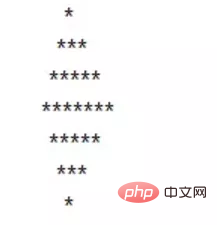值得收藏的30道Python練手題(附詳解)

1. 已知一個字串為 “hello_world_yoyo”,如何得到一個佇列 [“hello”,”world”,”yoyo”] ?
使用split 函數,分割字串,並且將資料轉換成列表類型:
test = 'hello_world_yoyo'
print(test.split("_"))
12結果:
['hello', 'world', 'yoyo']
2. 有一個列表[“hello”, “world ”, “yoyo”],如何把清單裡面的字串聯起來,得到字串「hello_world_yoyo」?
使用join 函數將資料轉換成字串:
test = ["hello", "world", "yoyo"]
print("_".join(test))結果:
hello_world_yoyo
如果不依賴python 提供的join 方法,也可以透過for 循環,然後將字符串拼接,但在用「 」連接字串時,結果會產生新的對象,使用join 時結果只是將原始列表中的元素拼接起來,所以join 效率比較高。
for 迴圈拼接如下:
test = ["hello", "world", "yoyo"]
# 定义一个空字符串
j = ''
# 通过 for 循环打印出列表中的数据
for i in test:
j = j + "_" + i
# 因为通过上面的字符串拼接,得到的数据是“_hello_world_yoyo”,前面会多一个下划线_,所以把这个下划线去掉
print(j.lstrip("_"))3. 把字串s 中的每個空格替換成” ”,輸入:s = “We are happy.”,輸出:“We are happy.」。
使用 replace 函數,替換字元換即可:
s = 'We are happy.'
print(s.replace(' ', '%20'))
12結果:
We%20are%20happy.
4. Python 如何列印 99 乘法表?
for 循環列印:
for i in range(1, 10):
for j in range(1, i+1):
print('{}x{}={}t'.format(j, i, i*j), end='')
print()while 循環實作:
i = 1
while i <= 9:
j = 1
while j <= i:
print("%d*%d=%-2d"%(i,j,i*j),end = ' ')# %d: 整数的占位符,'-2'代表靠左对齐,两个占位符
j += 1
print()
i += 1結果:
1x1=1 1x2=2 2x2=4 1x3=3 2x3=6 3x3=9 1x4=4 2x4=8 3x4=12 4x4=16 1x5=5 2x5=10 3x5=15 4x5=20 5x5=25 1x6=6 2x6=12 3x6=18 4x6=24 5x6=30 6x6=36 1x7=7 2x7=14 3x7=21 4x7=28 5x7=35 6x7=42 7x7=49 1x8=8 2x8=16 3x8=24 4x8=32 5x8=40 6x8=48 7x8=56 8x8=64 1x9=9 2x9=18 3x9=27 4x9=36 5x9=45 6x9=54 7x9=63 8x9=72 9x9=81
5. 從下標0 開始索引,找出單字“ welcome」 在字串「Hello, welcome to my world.」 中出現的位置,找不到回傳-1。
def test(): message = 'Hello, welcome to my world.' world = 'welcome' if world in message: return message.find(world) else: return -1 print(test())
結果:
7
6. 統計字串「Hello, welcome to my world.」 中字母 w 出現的次數。
def test(): message = 'Hello, welcome to my world.' # 计数 num = 0 # for 循环 message for i in message: # 判断如果 ‘w’ 字符串在 message 中,则 num +1 if 'w' in i: num += 1 return num print(test()) # 结果 2
7. 輸入一個字串str,輸出第m 個只出現過n 次的字符,如在字串gbgkkdehh 中,找出第2 個只出現1 次的字符,輸出結果:d
def test(str_test, num, counts):
"""
:param str_test: 字符串
:param num: 字符串出现的次数
:param count: 字符串第几次出现的次数
:return:
"""
# 定义一个空数组,存放逻辑处理后的数据
list = []
# for循环字符串的数据
for i in str_test:
# 使用 count 函数,统计出所有字符串出现的次数
count = str_test.count(i, 0, len(str_test))
# 判断字符串出现的次数与设置的counts的次数相同,则将数据存放在list数组中
if count == num:
list.append(i)
# 返回第n次出现的字符串
return list[counts-1]
print(test('gbgkkdehh', 1, 2))
结果:
d8. 判斷字串a = “welcome to my world” 是否包含單字b = “world”,包含傳回True,不包含回傳False。
def test(): message = 'welcome to my world' world = 'world' if world in message: return True return False print(test()) 结果: True
9. 從0 開始計數,輸出指定字串
def test(): message = 'hi how are you hello world, hello yoyo!' world = 'hello' return message.find(world) print(test()) 结果: 15
10. 從0 開始計數,輸出指定字串A = “hello”在字串B = “hi how are you hello world, hello yoyo!」中最後出現的位置,如果B 不包含A,則輸出-1。
def test(string, str):
# 定义 last_position 初始值为 -1
last_position = -1
while True:
position = string.find(str, last_position+1)
if position == -1:
return last_position
last_position = position
print(test('hi how are you hello world, hello yoyo!', 'hello'))
结果:
2811. 給定一個數 a,判斷一個數字是否為奇數或偶數。
while True:
try:
# 判断输入是否为整数
num = int(input('输入一个整数:'))
# 不是纯数字需要重新输入
except ValueError:
print("输入的不是整数!")
continue
if num % 2 == 0:
print('偶数')
else:
print('奇数')
break
结果:
输入一个整数:100
偶数12. 輸入一個姓名,判斷是否姓王。
def test():
user_input = input("请输入您的姓名:")
if user_input[0] == '王':
return "用户姓王"
return "用户不姓王"
print(test())
结果:
请输入您的姓名:王总
用户姓王13. 如何判斷一個字串是不是純數字組成?
利用 Python 提供的類型轉行,將使用者輸入的資料轉換成浮點數類型,如果轉換拋異常,則判斷數字不是純數字組成。
def test(num):
try:
return float(num)
except ValueError:
return "请输入数字"
print(test('133w3'))14. 將字串 a = “This is string example….wow!” 全部轉成大寫,字串 b = “Welcome To My World” 全部轉成小寫。
a = 'This is string example….wow!' b = 'Welcome To My World' print(a.upper()) print(b.lower())
15. 將字串a = “ welcome to my world ”首尾空格去掉
Python 提供了strip() 方法,可以去除首尾空格,rstrip() 去掉尾部空格,lstrip () 去掉首部空格,replace(" ", “”) 去掉全部空格。
a = 'welcome to my world ' print(a.strip())
還可以透過遞歸的方式實現:
def trim(s):
flag = 0
if s[:1]==' ':
s = s[1:]
flag = 1
if s[-1:] == ' ':
s = s[:-1]
flag = 1
if flag==1:
returntrim(s)
else:
return s
print(trim('Hello world!'))透過while 循環實現:
def trim(s):
while(True):
flag = 0
if s[:1]==' ':
s = s[1:]
flag = 1
if s[-1:] == ' ':
s = s[:-1]
flag = 1
if flag==0:
break
return s
print(trim('Hello world!'))16. 將字串s = “ajldjlajfdljfddd”,去重並從小到大排序輸出”adfjl」。
def test(): s = 'ajldjlajfdljfddd' # 定义一个数组存放数据 str_list = [] # for循环s字符串中的数据,然后将数据加入数组中 for i in s: # 判断如果数组中已经存在这个字符串,则将字符串移除,加入新的字符串 if i in str_list: str_list.remove(i) str_list.append(i) # 使用 sorted 方法,对字母进行排序 a = sorted(str_list) # sorted方法返回的是一个列表,这边将列表数据转换成字符串 return "".join(a) print(test()) 结果: adfjl
17. 印出以下圖案(菱形):

def test():
n = 8
for i in range(-int(n/2), int(n/2) + 1):
print(" "*abs(i), "*"*abs(n-abs(i)*2))
print(test())
结果:
**
****
******
********
******
****
**18. 給予一個不多於5 位元的正整數(如a = 12346 ),求它是幾位數和逆序印出各位數字。
class Test:
# 计算数字的位数
def test_num(self, num):
try:
# 定义一个 length 的变量,来计算数字的长度
length = 0
while num != 0:
# 判断当 num 不为 0 的时候,则每次都除以10取整
length += 1
num = int(num) // 10
if length > 5:
return "请输入正确的数字"
return length
except ValueError:
return "请输入正确的数字"
# 逆序打印出个位数
def test_sorted(self, num):
if self.test_num(num) != "请输入正确的数字":
# 逆序打印出数字
sorted_num = num[::-1]
# 返回逆序的个位数
return sorted_num[-1]
print(Test().test_sorted('12346'))
结果:
119. 若一個 3 位數等於其各位數的立方和,則稱這個數為水仙花數。例如:153 = 13 53 33,因此 153 就是一個水仙花數。那麼如何求 1000 以內的水仙花數(3 位數)。
def test(): for num in range(100, 1000): i = num // 100 j = num // 10 % 10 k = num % 10 if i ** 3 + j ** 3 + k ** 3 == num: print(str(num) + "是水仙花数") test()
20. 求 1 2 3… 100 相加的和。
i = 1 for j in range(101): i = j + i print(i) 结果: 5051
21. 計算 1-2 3-4 5-…-100 的值。
def test(sum_to): # 定义一个初始值 sum_all = 0 # 循环想要计算的数据 for i in range(1, sum_to + 1): sum_all += i * (-1) ** (1 + i) return sum_all if __name__ == '__main__': result = test(sum_to=100) print(result) -50
22. 現有計算公式 13 23 33 43 ……. n3,如何實現:當輸入 n = 5 時,輸出 225(對應的公式 : 13 23 33 43 53 = 225)。
def test(n): sum = 0 for i in range(1, n+1): sum += i*10+i return sum print(test(5)) 结果: 225
23. 已知a 的值為“hello”,b 的值為“world”,如何交換a 和b 的值,得到a 的值為“world”,b 的值為”hello ”?
a = 'hello' b = 'world' c = a a = b b = c print(a, b)
24. 如何判斷一個陣列是對稱數組?
例如 [1,2,0,2,1],[1,2,3,3,2,1],這樣的陣列都是對稱數組。用 Python 判斷,是對稱數組印出 True,不是印出 False。
def test(): x = [1, 'a', 0, '2', 0, 'a', 1] # 通过下标的形式,将字符串逆序进行比对 if x == x[::-1]: return True return False print(test()) 结果: True
25. 如果有一個列表a = [1,3,5,7,11],那麼如何讓它反轉成[11,7,5,3,1],並且取到奇數位值的數字[1,5,11]?
def test(): a = [1, 3, 5, 7, 11] # 逆序打印数组中的数据 print(a[::-1]) # 定义一个计数的变量 count = 0 for i in a: # 判断每循环列表中的一个数据,则计数器中会 +1 count += 1 # 如果计数器为奇数,则打印出来 if count % 2 != 0: print(i) test() 结果: [11, 7, 5, 3, 1] 1 5 11
26. 對列表 a = [1, 6, 8, 11, 9, 1, 8, 6, 8, 7, 8] 中的數字從小到大排序。
a = [1, 6, 8, 11, 9, 1, 8, 6, 8, 7, 8] print(sorted(a)) 结果: [1, 1, 6, 6, 7, 8, 8, 8, 8, 9, 11]
27. 找出列表 L1 = [1, 2, 3, 11, 2, 5, 3, 2, 5, 33, 88] 中最大值和最小值。
L1 = [1, 2, 3, 11, 2, 5, 3, 2, 5, 33, 88] print(max(L1)) print(min(L1)) 结果: 88 1
上面是透過 Python 自帶的函數實現,如下,可以自己寫一個計算程式:
class Test(object): def __init__(self): # 测试的列表数据 self.L1 = [1, 2, 3, 11, 2, 5, 3, 2, 5, 33, 88] # 从列表中取第一个值,对于数据大小比对 self.num = self.L1[0] def test_small_num(self, count): """ :param count: count为 1,则表示计算最大值,为 2 时,表示最小值 :return: """ # for 循环查询列表中的数据 for i in self.L1: if count == 1: # 循环判断当数组中的数据比初始值小,则将初始值替换 if i > self.num: self.num = i elif count == 2: if i < self.num: self.num = i elif count != 1 or count != 2: return "请输入正确的数据" return self.num print(Test().test_small_num(1)) print(Test().test_small_num(2)) 结果: 88 1
28. 找出列表 a = [“hello”, “world”, “yoyo”, “congratulations”] 中单词最长的一个。
def test(): a = ["hello", "world", "yoyo", "congratulations"] # 统计数组中第一个值的长度 length = len(a[0]) for i in a: # 循环数组中的数据,当数组中的数据比初始值length中的值长,则替换掉length的默认值 if len(i) > length: length = i return length print(test()) 结果: congratulations
29. 取出列表 L1 = [1, 2, 3, 11, 2, 5, 3, 2, 5, 33, 88] 中最大的三个值。
def test(): L1 = [1, 2, 3, 11, 2, 5, 3, 2, 5, 33, 88] return sorted(L1)[:3] print(test()) 结果: [1, 2, 2]
30. 把列表 a = [1, -6, 2, -5, 9, 4, 20, -3] 中的数字绝对值。
def test(): a = [1, -6, 2, -5, 9, 4, 20, -3] # 定义一个数组,存放处理后的绝对值数据 lists = [] for i in a: # 使用 abs() 方法处理绝对值 lists.append(abs(i)) return lists print(test()) 结果: [1, 6, 2, 5, 9, 4, 20, 3]
以上是值得收藏的30道Python練手題(附詳解)的詳細內容。更多資訊請關注PHP中文網其他相關文章!

熱AI工具

Undresser.AI Undress
人工智慧驅動的應用程序,用於創建逼真的裸體照片

AI Clothes Remover
用於從照片中去除衣服的線上人工智慧工具。

Undress AI Tool
免費脫衣圖片

Clothoff.io
AI脫衣器

Video Face Swap
使用我們完全免費的人工智慧換臉工具,輕鬆在任何影片中換臉!

熱門文章

熱工具

記事本++7.3.1
好用且免費的程式碼編輯器

SublimeText3漢化版
中文版,非常好用

禪工作室 13.0.1
強大的PHP整合開發環境

Dreamweaver CS6
視覺化網頁開發工具

SublimeText3 Mac版
神級程式碼編輯軟體(SublimeText3)
 PHP和Python:解釋了不同的範例
Apr 18, 2025 am 12:26 AM
PHP和Python:解釋了不同的範例
Apr 18, 2025 am 12:26 AM
PHP主要是過程式編程,但也支持面向對象編程(OOP);Python支持多種範式,包括OOP、函數式和過程式編程。 PHP適合web開發,Python適用於多種應用,如數據分析和機器學習。
 Python vs. JavaScript:學習曲線和易用性
Apr 16, 2025 am 12:12 AM
Python vs. JavaScript:學習曲線和易用性
Apr 16, 2025 am 12:12 AM
Python更適合初學者,學習曲線平緩,語法簡潔;JavaScript適合前端開發,學習曲線較陡,語法靈活。 1.Python語法直觀,適用於數據科學和後端開發。 2.JavaScript靈活,廣泛用於前端和服務器端編程。
 在PHP和Python之間進行選擇:指南
Apr 18, 2025 am 12:24 AM
在PHP和Python之間進行選擇:指南
Apr 18, 2025 am 12:24 AM
PHP適合網頁開發和快速原型開發,Python適用於數據科學和機器學習。 1.PHP用於動態網頁開發,語法簡單,適合快速開發。 2.Python語法簡潔,適用於多領域,庫生態系統強大。
 vs code 可以在 Windows 8 中運行嗎
Apr 15, 2025 pm 07:24 PM
vs code 可以在 Windows 8 中運行嗎
Apr 15, 2025 pm 07:24 PM
VS Code可以在Windows 8上運行,但體驗可能不佳。首先確保系統已更新到最新補丁,然後下載與系統架構匹配的VS Code安裝包,按照提示安裝。安裝後,注意某些擴展程序可能與Windows 8不兼容,需要尋找替代擴展或在虛擬機中使用更新的Windows系統。安裝必要的擴展,檢查是否正常工作。儘管VS Code在Windows 8上可行,但建議升級到更新的Windows系統以獲得更好的開發體驗和安全保障。
 visual studio code 可以用於 python 嗎
Apr 15, 2025 pm 08:18 PM
visual studio code 可以用於 python 嗎
Apr 15, 2025 pm 08:18 PM
VS Code 可用於編寫 Python,並提供許多功能,使其成為開發 Python 應用程序的理想工具。它允許用戶:安裝 Python 擴展,以獲得代碼補全、語法高亮和調試等功能。使用調試器逐步跟踪代碼,查找和修復錯誤。集成 Git,進行版本控制。使用代碼格式化工具,保持代碼一致性。使用 Linting 工具,提前發現潛在問題。
 PHP和Python:深入了解他們的歷史
Apr 18, 2025 am 12:25 AM
PHP和Python:深入了解他們的歷史
Apr 18, 2025 am 12:25 AM
PHP起源於1994年,由RasmusLerdorf開發,最初用於跟踪網站訪問者,逐漸演變為服務器端腳本語言,廣泛應用於網頁開發。 Python由GuidovanRossum於1980年代末開發,1991年首次發布,強調代碼可讀性和簡潔性,適用於科學計算、數據分析等領域。
 vscode怎麼在終端運行程序
Apr 15, 2025 pm 06:42 PM
vscode怎麼在終端運行程序
Apr 15, 2025 pm 06:42 PM
在 VS Code 中,可以通過以下步驟在終端運行程序:準備代碼和打開集成終端確保代碼目錄與終端工作目錄一致根據編程語言選擇運行命令(如 Python 的 python your_file_name.py)檢查是否成功運行並解決錯誤利用調試器提升調試效率
 vscode 擴展是否是惡意的
Apr 15, 2025 pm 07:57 PM
vscode 擴展是否是惡意的
Apr 15, 2025 pm 07:57 PM
VS Code 擴展存在惡意風險,例如隱藏惡意代碼、利用漏洞、偽裝成合法擴展。識別惡意擴展的方法包括:檢查發布者、閱讀評論、檢查代碼、謹慎安裝。安全措施還包括:安全意識、良好習慣、定期更新和殺毒軟件。






